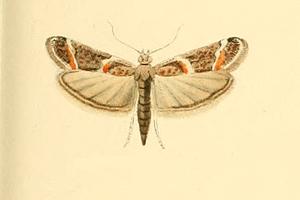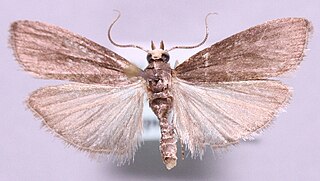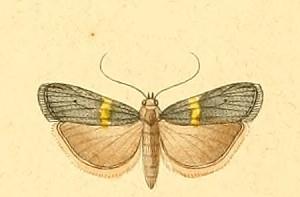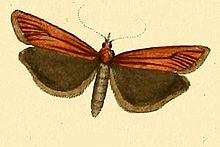
The Philadelphia Zoo, located in the Centennial District of Philadelphia on the west bank of the Schuylkill River, is the first true zoo in the United States. It was chartered by the Commonwealth of Pennsylvania on March 21, 1859, but its opening was delayed by the Civil War until July 1, 1874. The zoo opened with 1,000 animals and an admission price of 25 cents. For a brief time, the zoo also housed animals brought to U.S. from safaris by the Smithsonian Institution, which had not yet built its National Zoo.

The Crambidae are the grass moth family of lepidopterans. They are variable in appearance, the nominal subfamily Crambinae taking up closely folded postures on grass stems where they are inconspicuous, while other subfamilies include brightly coloured and patterned insects which rest in wing-spread attitudes.

The term fish kill, known also as fish die-off, refers to a localized die-off of fish populations which may also be associated with more generalized mortality of aquatic life. The most common cause is reduced oxygen in the water, which in turn may be due to factors such as drought, algae bloom, overpopulation, or a sustained increase in water temperature. Infectious diseases and parasites can also lead to fish kill. Toxicity is a real but far less common cause of fish kill.
In biological taxonomy, circumscription is the content of a taxon, that is, the delimitation of which subordinate taxa are parts of that taxon. If we determine that species X, Y, and Z belong in Genus A, and species T, U, V, and W belong in Genus B, those are our circumscriptions of those two genera. Another systematist might determine that T, U, V, W, X, Y, and Z all belong in genus A. Agreement on circumscriptions is not governed by the Codes of Zoological or Botanical Nomenclature, and must be reached by scientific consensus.
Atralata is a genus of moths of the family Crambidae. It contains only one species, Atralata albofascialis, which is found in most of Europe, except Ireland, Great Britain, Norway, Finland, Lithuania and Greece.

Evergestis is a genus of moths of the family Crambidae described by Jacob Hübner in 1825. A number of species are pests, including the cross-striped cabbageworm, a pest of cole crops such as cabbage.
Paracorsia is a monotypic moth genus of the family Crambidae described by H. Marion in 1959. It contains only one species, Paracorsia repandalis, described by Michael Denis and Ignaz Schiffermüller in 1775. It is found in most of Europe, except Ireland, Fennoscandia and the Baltic region. It has also been recorded from central Asia, including Iran and Kyrgyzstan and North America where it has been recorded in southern Ontario and northern Indiana.

Amyelois is a monotypic snout moth genus described by Hans Georg Amsel in 1956. Its single species, Amyelois transitella, the navel orangeworm, described by Francis Walker in 1863, is endemic to the tropical Western Hemisphere, including the southern United States. Its abundance in California increased greatly during the first half of the 20th century.
Ancylosis brunneella is a species of snout moth in the genus Ancylosis. It was described by Pierre Chrétien in 1911 and is known from Spain, Algeria Morocco, Tunisia, Libya, Egypt, Sudan, Saudi Arabia and the Palestinian territories.
Ancylosis citrinella is a species of snout moth in the genus Ancylosis. It was described by Émile Louis Ragonot, in 1887. It is found in Algeria.
Ancylosis harmoniella is a species of snout moth in the genus Ancylosis. It was described by Émile Louis Ragonot, in 1887 from Spain, Malta, Turkey, Algeria, Morocco, Tunisia, Libya, Egypt, Saudi Arabia, the Palestinian Territories, Syria, Iraq, Iran, Afghanistan and Transcaucasia.

Ancylosis samaritanella is a species of snout moth in the genus Ancylosis. It was described by Zeller in 1867. It is found in Spain, Russia, Turkey, Jordan, the Canary Islands, Morocco, Algeria, Tunisia, Libya, Egypt, Sudan, Saudi Arabia, Turkestan and Central Asia.

Anerastia lotella is a species of snout moth in the genus Anerastia. It was described by Jacob Hübner in 1813. It is found in most of Europe, western Russia, Asia Minor, Iran and western Turkestan. It has also been recorded from most of Canada.

Aphomia zelleri is a species of snout moth in the genus Aphomia. It was described by Joseph de Joannis in 1932, and is known from Central Asia and most of Europe.

Acrobasis legatea is a species of snout moth in the genus Acrobasis. It was described by Adrian Hardy Haworth in 1811. It is found in most of Europe, except the north, east to Russia and Kazakhstan.

Isauria dilucidella is a species of moth in the family Pyralidae. It was described by Philogène Auguste Joseph Duponchel in 1836. It is found in most of Europe, Algeria, the United Arab Emirates, Syria, Lebanon, the Palestinian territories, Iraq, Turkmenistan, Mongolia, as well as Georgia, Kazakhstan, Armenia, Turkey, Iran and Afghanistan.

Selagia argyrella is a species of snout moth. It is found in almost all of Europe, except Ireland, Norway, Finland, Estonia, Ukraine and Portugal. In the east, the range extends to Asia.

Salebriopsis is a monotypic snout moth genus erected by Hans-Joachim Hannemann in 1965. Its single species, Salebriopsis albicilla, was first described by Gottlieb August Wilhelm Herrich-Schäffer in 1849. It is found in most of Europe, except Ireland, Portugal, most of the Balkan Peninsula and Ukraine.

Oxybia is a monotypic snout moth genus described by Hans Rebel in 1901. Its only species, Oxybia transversella, was described by Philogène Auguste Joseph Duponchel in 1836. It is found in southern Europe and on the Canary Islands.
Nephopterygia is a monotypic snout moth genus described by Hans Georg Amsel in 1965. Its only species, N. austeritella, described by the same author, is found on the Canary Islands, as well as in Sudan and Egypt.











